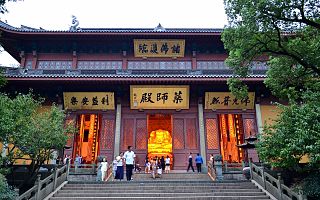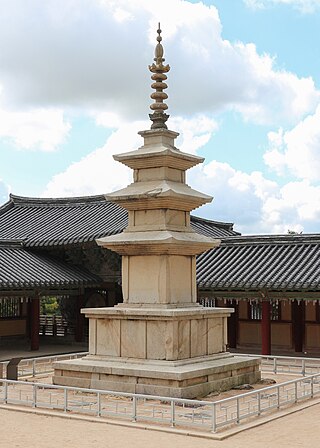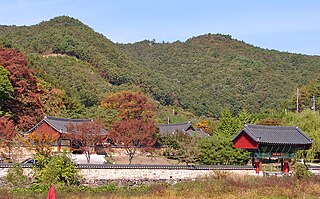
Bulguksa (Korean: 불국사) is a Buddhist temple on Tohamsan, in Jinhyeon-dong, Gyeongju, North Gyeongsang Province, South Korea.

Mireuksa (Korean: 미륵사) was the largest Buddhist temple in the ancient Korean kingdom of Baekje. The temple was established in 602 by King Mu and is located 36.012083 N, 127.031028 E, modern Iksan, North Jeolla Province, South Korea. The site was excavated in 1980, disclosing many hitherto unknown facts about Baekje architecture. Mireuksaji Stone Pagoda is one of two extant Baekje pagodas. It is also the largest as well as being among the oldest of all Korean pagodas.

Lingyin Temple is a Buddhist temple of the Chan sect located north-west of Hangzhou, Zhejiang Province, China. The temple's name is commonly translated into English as Temple of the Soul's Retreat, which is a literal translation of the Chinese. It is one of the largest and wealthiest Buddhist temples in China, and contains numerous pagodas and Buddhist grottoes.

Hwangnyongsa (Korean: 황룡사), alternatively Hwangnyong Temple or Hwangryongsa, was a Buddhist temple in the city of Gyeongju, South Korea.

Beomeosa is one of the head temples of the Jogye Order of Korean Buddhism in Cheongnyeongnopo-dong, Geumjeong District, Busan, South Korea. Built on the slopes of the mountain Geumjeongsan, it is one of the country's best known temples.

Beopjusa, is a head temple of the Jogye Order of Korean Buddhism. It is situated on the slopes of Songnisan, within Songnisan National Park, in Naesongni-myeon, Boeun County, in the province of Chungcheongbuk-do, South Korea.

Woljeongsa (Korean: 월정사) is a head temple of the Jogye Order of Korean Buddhism, located on the eastern slopes of Odaesan in Pyeongchang County, Gangwon Province, South Korea. Woljeongsa was founded in 643 by the Silla monk Jajang.

Geumsansa is a temple of the Jogye Order of Korean Buddhism standing on the slopes of Moaksan in Gimje City, Jeollabuk-do, South Korea.

Seokgatap (Korean: 석가탑) is a stone pagoda in South Korea designated as the 21st National Treasure on December 12, 1962. Its full name is Sakyamuni Yeoraesangjuseolbeop Tap, and is sometimes referred to as the Shadowless Pagoda or the Bulguksa Samcheung Seoktap.

Bunhwangsa is a temple complex from the Old Silla era of Korea. It is located in Gyeongju. The temple is recorded to have been built in 634 under the auspices of Queen Seondeok. Today the temple is still used by a small group of worshipers but in its heyday, the temple covered several acres and was one of the four main temples of the Silla Kingdom used by the state to ask the Buddha to bless the kingdom. The ruins of Hwangnyongsa Temple lay nearby. It is part of the UNESCO world heritage site Gyeongju Historic Areas.

Unjusa or Unju Temple is a Korean Buddhist temple located in Hwasun County, South Jeolla province, South Korea. It is 26 km (16 mi) southwest of Hwasun County or 40 km (24 mi) south of Gwangju. Compared with other temples in South Korea, this temple has an unusual collection of stone Buddha statues and stone pagodas, so Unjusa is often referred to as the mysterious temple. Among several assumptions regarding its origin, the most widely known one is that Monk Doseon founded the temple based on geomancy during the late period of Silla Dynasty, but the origins remain unverified.

The Guoqing Temple is a Buddhist temple on Mount Tiantai, in Taizhou, Zhejiang Province, China. Originally built in 598 CE during the Sui dynasty, and renovated during the reign of the Qing Yongzheng Emperor, the temple is located roughly 220 kilometres (140 mi) from the city of Hangzhou. It was the initial site for the creation of the Tiantai school of Mahāyāna Buddhism, founded by the Chinese Buddhist teacher Zhiyi. The temple covers an area of some 23,000 m2 (250,000 sq ft) and features 600 rooms in a total of 14 different halls, including the Grand Hall of Sakyamuni, the Hall of Five Hundred Arhats and the Hall of Monk Jigong. The exterior of the building features Chinese pagodas such as the Sui Pagoda, the Seven Buddha Pagoda, and the Memorial Pagoda of Monk Yi Xing.

This is the glossary of Japanese Buddhism, including major terms the casual reader might find useful in understanding articles on the subject. Words followed by an asterisk (*) are illustrated by an image in one of the photo galleries. Within definitions, words set in boldface are defined elsewhere in the glossary.

The Dajue Temple is a Buddhist temple located in the Haidian District of western Beijing, China. It was founded in the 11th century, and the current temple dates to a reconstruction in the 15th century during the Ming Dynasty. It contains three main halls, a gate, a pagoda and various side halls.

The Buddha Tooth Relic Temple and Museum is a Buddhist temple and museum complex located in the Chinatown district of Singapore. The temple's monastics and devotees officially practice Chinese Buddhism.

Neunggasa is a Korean Buddhist temple located in Yeongnam-myeon township, Goheung-gun County, Jeollanam-do, South Korea.

Seonam Temple, or Seonamsa, is a Korean Buddhist temple on the eastern slope at the west end of Jogyesan Provincial Park, within the northern Seungjumyeon District of the city of Suncheon, South Jeolla Province, South Korea. It belongs to the Taego Order although the Jogye Order claims possession over it.

Ssangbongsa (Korean: 쌍봉사), or Ssangbong Temple, is part of the Jogye Order of Korean Buddhism located in rural Jeung Village, Iyang Township, Hwasun County, South Jeolla Province, South Korea.

Daci'en Temple is a Buddhist temple located in Yanta District, Xi'an, Shaanxi. The temple is the cradle of East Asian Yogācāra in China. It is notable for the Giant Wild Goose Pagoda. The pagoda was originally built by the monk Xuanzang, whose pilgrimage to India inspired the novel Journey to the West. Alongside Daxingshan Temple and Jianfu Temple, it was one of the three sutras translation sites (三大译经场) in the Tang dynasty.

Iksan Mireuksaji Stone Pagoda is located in Mireuksaji, Geumma-myeon, Iksan-si, Jeollabuk-do, and is the oldest stone pagoda remaining in Korea. It is designated as the 11th national treasure.




























